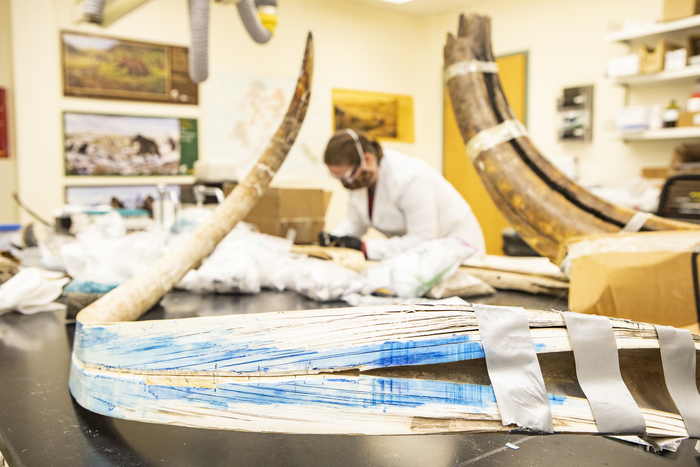Typically, fossils offer information about animals from the past. But understanding details about how the animal lived has not been previously possible. New techniques, however, are allowing more information to be gleaned from these artifacts. Now, an international research team has retraced the lifetime journey of an Arctic woolly mammoth (Mammuthus primigenius) and found that it covered enough of the Alaska landscape during its 28 years to almost circle the Earth twice.
Scientists gathered unprecedented details of the animal’s life through the analysis of a 17,000-year-old tusk fossil from the University of Alaska Museum of the North. By generating and studying isotopic data in the mammoth’s tusk, they were able to match its movements and diet with isotopic maps of the region, and present an outline of the mammoth’s life.
This research is published in Science in the article, “Lifetime mobility of an Arctic woolly mammoth.”
Few details have been known about the lives and movements—mobility and range—of woolly mammoths. This study offers the first evidence that they traveled vast distances.

Researchers at the Alaska Stable Isotope Facility, where Wooller is director, split the 6-foot tusk lengthwise and generated about 400,000 microscopic data points using a laser and other techniques. More specifically, they used, “high temporal resolution sequential analyses of strontium isotope ratios along an entire 1.7-meter-long tusk.”
The detailed isotope analyses they made are possible because of the way that mammoth tusks grew. Mammoths steadily added new layers on a daily basis throughout their lives. When the tusk was split lengthwise for sampling, these growth bands offered a chronological record of an entire mammoth’s life.
“From the moment they’re born until the day they die, they’ve got a diary and it’s written in their tusks,” said Pat Druckenmiller, PhD, assistant professor of geology at the University of Alaska Fairbanks. “Mother Nature doesn’t usually offer up such convenient and life-long records of an individual’s life.”
Scientists knew that the mammoth died on Alaska’s North Slope above the Arctic Circle, where its remains were excavated. Researchers pieced together the mammoth’s journey up to that point by analyzing isotopic signatures in its tusk from the elements strontium and oxygen, which were matched with maps predicting isotope variations across Alaska. Researchers created the maps by analyzing the teeth of hundreds of small rodents from across Alaska held in the museum’s collections. The animals travel relatively small distances during their lifetimes and represent local isotope signals.

Using that local dataset, they mapped isotope variation across Alaska, providing a baseline to trace the mammoth movements. After taking geographic barriers into account and the average distance it traveled each week, researchers used a novel spatial modeling approach to chart the likely routes the animal took during its life.
Ancient DNA preserved in the mammoth’s remains allowed the team to identify it as a male that was related to the last group of its species that lived in mainland Alaska. Those details provided more insight into the animal’s life and behavior, said Beth Shapiro, PhD, professor at the University of California, Santa Cruz, and investigator at the Howard Hughes Medical Institute who led the DNA component of the study.
“Knowing that he was male provided a better biological context in which we could interpret the isotopic data,” said Shapiro. For example, an abrupt shift in its isotopic signature, ecology and movement at about age 15 probably coincided with the mammoth being kicked out of its herd, mirroring a pattern seen in some modern-day male elephants.
Isotopes also offered a clue about what led to the animal’s demise. Nitrogen isotopes spiked during the final winter of its life, a signal that can be a hallmark of starvation in mammals.
Discovering more about the lives of extinct species satisfies more than curiosity, said Wooller. Those details could be surprisingly relevant today as many species adapt their movement patterns and ranges with the shifting climate.
“The Arctic is seeing a lot of changes now, and we can use the past to see how the future may play out for species today and in the future,” Wooller said. “Trying to solve this detective story is an example of how our planet and ecosystems react in the face of environmental change.”



